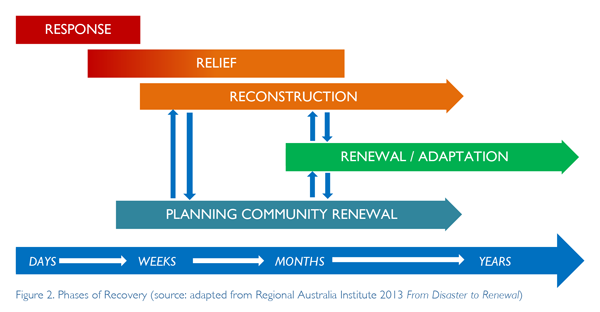
Recovery (short/long term) is the period following a disaster and the community’s early response to that disaster, whereby things return to a new normal. After neighbors move from shock to action, communities organize by implementing plans and structures aimed at bringing help to affected individuals and families in a holistic, integrated process that brings needed resources to the most vulnerable.
There are two phases of recovery:
Short term recovery
- Many emergency and relief programs complete their work.
- Restoration of infrastructure and vital life support systems happen in this phase.
- The community identifies local resources to form a long term recovery group (LTRG), and initiation of plans for permanent housing begins.
Long term recovery
- Transition occurs between the presence of national organizations and the local community.
- Implementation begins for disaster case management and recovery initiatives administered by the local community.
- Construction activities to include repairing, rebuilding and/or relocation of homes proceeds during this phase.
- Resumption of the routines of daily life characterizes this phase.
Recovering from Disaster
Recovering from a disaster is usually a gradual process. Safety is a primary issue, as are mental and physical well-being. If assistance is available, knowing how to access it makes the process faster and less stressful. This section offers some general advice on steps to take after disaster strikes in order to begin getting your home, your community and your life back to normal.
There are four major categories, these are as follows:
- Health and safety plans
- Returning home
- Coping with disaster
- Helping others
Health and safety plans
Safety is a fundamental concern, as are mental and physical well- being. If relief is accessible, knowing how to access it makes the process faster and less traumatic.
Your primary concern after a disaster is your family’s health and safety. You need to consider probable safety issues and monitor family health and well-being.
Aiding the Injured
- Administer first aid and seek medical care for anyone who has been injured following a disaster.
- Check for injuries. Do not attempt to move seriously injured persons unless they are in instant danger of death or further injury. If you must move an unconscious person, first alleviate the neck and back, then call for help immediately.
- If the victim is not breathing, carefully position the victim for artificial respiration, clear the airway and commence mouth-to-mouth resuscitation.
- Sustain body temperature with blankets. Be sure the victim does not become overheated.
- Under no circumstances try to feed liquids to an unconscious person.
- Health
- Be mindful of exhaustion. Don’t try to do too much at once. Set priorities and pace yourself. Get enough rest.
- Drink plenty of clean water. Eat well.
- Wear sturdy work boots and gloves.
- Wash your hands thoroughly with soap and clean water often when working in debris.
Safety issues
Be aware of safety issues after a disaster.
- Be alert of new safety issues created by the disaster. Watch for road blockage, contaminated water, gas leaks, collapsed trees, broken glass, damaged electrical wiring and fallen pole.
- Inform local authorities about health and safety issues, including downed power lines, road blockage, smoldering insulation and dead animals etc.
